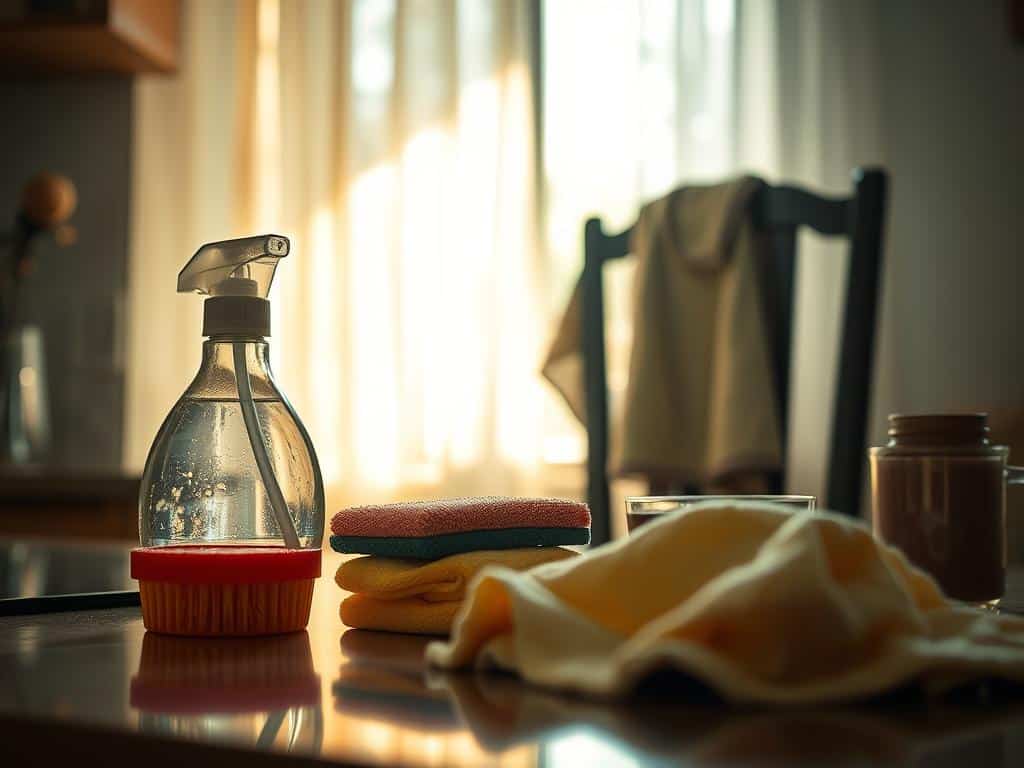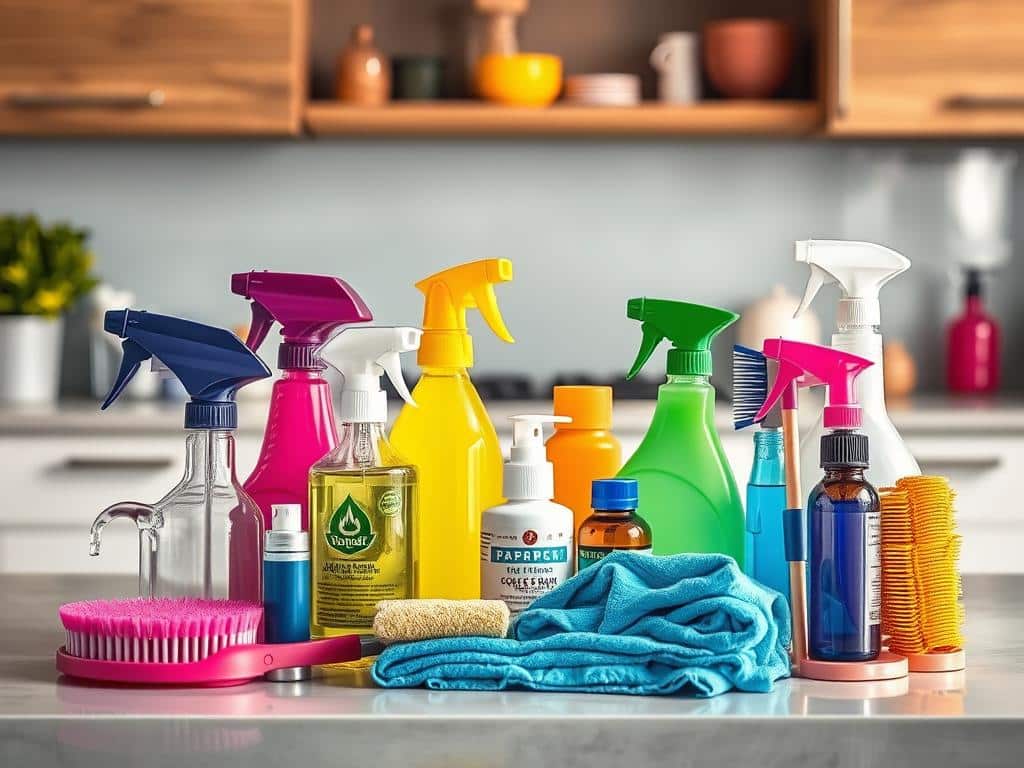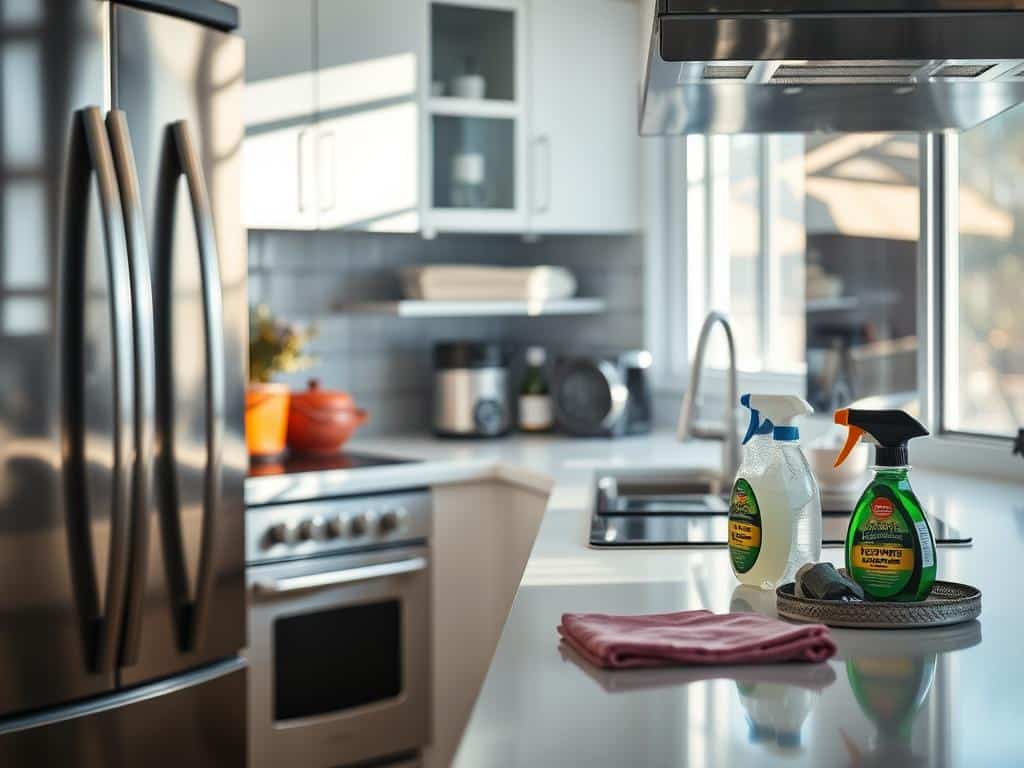
Life is full of ups and downs, and with them come stains. Spilled coffee and sudden wine drops can be annoying. But, they don’t have to last forever on your clothes or carpets. This guide gives you top tips to remove stains well. You’ll learn how to keep your items looking new.
Dealing with stains fast and right keeps your clothes spotless. Save your favorite pieces from damage. Whether it’s getting coffee stains out of clothing with what you have at home, or beating wine stains, this guide has you covered.
Common Types of Stains
Dealing with stains is a common household challenge. Knowing the right stain removal solutions can make a big difference. We explore some of the most frequent stain types and give effective tips for dealing with them. Prompt action is vital to stop stains from setting. The longer they remain untreated, the harder they are to remove.
Coffee Stains
Coffee stains are a common nuisance. By using special tips, you can quickly address these. Gently blot the area and apply a mix of warm water, dish soap, and vinegar to the stain. This mix is a great way to remove coffee spills.
Wine Stains
Wine stains, especially red wine, are tough to tackle. Start by blotting the stain. A popular solution is Wine Away, but a mix of hydrogen peroxide and blue dish soap is also effective. Remember to rinse well to remove any leftover chemicals.
Oil and Grease Stains
Oil and grease stains demand specific advice for effective removal. First, blot the stain, then use baking soda to absorb the grease. Next, dish soap helps remove the stain with warm water washing.
Blood Stains
Blood stains can be tough, but quick treatment is key. Soak the fabric in cold water and white vinegar. Another method uses enzyme-based detergents. Let the solution work for at least 30 minutes, then rinse with cool water.
Paint Stains
Paint stains require fast action before the paint sets. The treatment depends on the paint type. For water-based paint, warm water rinsing and laundry detergent work well. Use rubbing alcohol or a paint remover for oil-based paints.
| Stain Type | Initial Treatment | Recommended Solution |
|---|---|---|
| Coffee | Blot and apply dish soap, warm water, vinegar | Mix and treat with dish soap, warm water, and vinegar |
| Wine | Blot, rinse with cool water | Use Wine Away or mix hydrogen peroxide with blue dish soap |
| Oil and Grease | Blot and apply baking soda | Use baking soda, then dish soap and warm water |
| Blood | Soak in cold water with white vinegar | Use enzyme-based detergent |
| Paint | Act quickly, rinse with warm water | Use warm water for water-based, rubbing alcohol for oil-based |
General Stain Removal Tips
Stains can be tough, but the right advice helps you beat them. These tips will make sure your fabrics stay safe.
Act Quickly
Quick action is key to getting rid of stains. The sooner you deal with it, the better. Quick stain action means it’s less likely to stick around. Try to scrape off any solid bits first and treat the stain before it dries.
Blot, Don’t Rub
Got a fresh stain? Don’t rub it! Rubbing pushes the stain in deeper. Blot it gently with something absorbent for best results.
Use Cold Water
Use cold water on stains like blood or egg. Warm water will make them permanent. Start with a cold water soak, then move to stain treatment.
Test Before Treating
Always test cleaners on a small hidden part of your fabric. This prevents damage. It’s especially important for delicate items like silk or wool.
-
Look at the care label before you start.
-
Do a patch test with your stain remover.
-
Act fast to avoid the stain setting in.
-
Blot stains carefully with a clean pad.
-
Start with cold water on protein-based stains.
How to Remove Stains From Different Fabrics
Knowing how to take care of different fabrics is crucial for removing stains. You must treat each fabric type in a special way to keep your clothes and textiles looking great. This includes everything from caring for cotton to treating synthetic fabrics, and following guidelines for wool stains. Let’s dive into the best methods for dealing with common fabric types to keep your items looking their best.
Cotton and Linen
Cotton and linen are strong but need careful handling to stay clean. Start by putting a stain remover or a mix of dish soap and baking soda on the stain. Then, gently dab the spot and wash the fabric in cold water. For stubborn stains, you can try hydrogen peroxide, but first check it on a hidden part of the fabric.
Synthetic Fabrics
Dealing with synthetic fabrics takes a bit of caution since they’re not great with heat. To tackle a stain, dab a little detergent on it and rub the fabric gently. Then, rinse it off with cold water and check the stain before washing it as you normally would. Stay away from bleach and hot water to prevent damage.
Wool and Silk
Wool and silk are delicate and need extra care. When cleaning wool, softly use a sponge mixed with cold water and rubbing alcohol. For silk, go with a gentle detergent or get it professionally cleaned, and don’t rub it. Always let these fabrics air dry out of direct sunlight to prevent shrinking and other damage.
| Fabric Type | Method | Precautions |
|---|---|---|
| Cotton and Linen | Pre-treat with stain remover; wash with cold water. | Test on small area first. |
| Synthetic Fabrics | Apply detergent directly; rinse with cold water. | Avoid bleach and hot water. |
| Wool and Silk | Gently sponge with rubbing alcohol (wool); use mild detergent (silk). | Air dry; avoid heat. |
Recommended Stain Removal Products
Choosing the right stain remover from so many options can seem hard. Various professional recommendations can guide you. They tested over 20 top stain removers on stains like red wine, chocolate, and olive oil.

The Method Stain Remover stands out as the best. It uses a plant-based formula and has a built-in brush. It’s great for many stains, such as grease, blood, and makeup. It works best on stains like grass, chocolate syrup, and olive oil.
The Shout Stain Remover is good for oil and grease. But, it’s less effective on wine stains. Yet, it’s affordable and easy to use, making it a great value.
The OxiClean Remover Powder is top-notch for red wine stains. It’s great for fresh and set-in stains on many surfaces. It’s also good for pre-soaking laundry.
| Product | Best For | Unique Feature | Price |
|---|---|---|---|
| Method Stain Remover | All-purpose | Built-in brush, plant-based | $9 |
| Shout Stain Remover | Oil and Grease | Unscented formula | $4 |
| OxiClean Remover Powder | Red Wine Stains | Can be used for pre-soak | $8 |
| Grandma’s Secret Stain Remover | Set-in Stains | Effective on old stains | $12 |
| Tide To Go Pen | On-the-go | Convenient pen format | $4 |
| Meliora Laundry Stain Remover Soap Stick | Eco-friendly | Coconut and sunflower oil ingredients | $10 |
The Meliora Laundry Stain Remover Soap Stick is great for those who love the planet. It uses coconut and sunflower oil and works well on many stains. Grandma’s Secret Stain Remover is good for old stains but not for red wine.
The Tide To Go Pen is perfect for quick fixes on fresh stains. It works on grass, marker, chocolate syrup, and olive oil stains, proving its usefulness.
In choosing cleaning products, think about the stains you usually face and if they’re safe for your fabrics. This list helps you feel ready to tackle any stain confidently.
Conclusion
Stains happen to everyone, but you can beat them. Knowing what caused the stain helps a lot. Whether it’s food, drink, ink, grease, or oil, acting fast makes a big difference. If you know the right trick, like using vinegar on coffee stains or glycerin for ink, you’re set.
You can use natural and store-bought products to get stains out, too. Lemon juice, baking soda, and enzyme cleaners are great choices. Always start with cold water and dab the stain, don’t rub it. This stops the stain from setting in before you can deal with it.
Dealing with tough stains might need a pro or special cleaning like steam cleaning. Yet, knowing how to act quickly and what to use is crucial. This guide gave you the basics and suggested products for all kinds of stains. Acting fast will keep your clothes looking new. Keeping your clothes clean and bright is all about what you know and how quickly you act.



